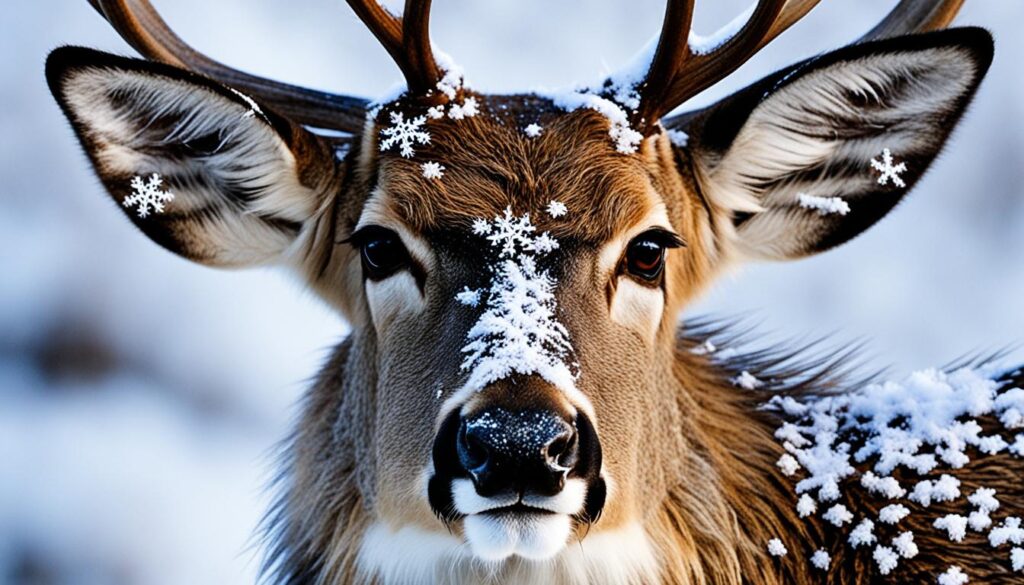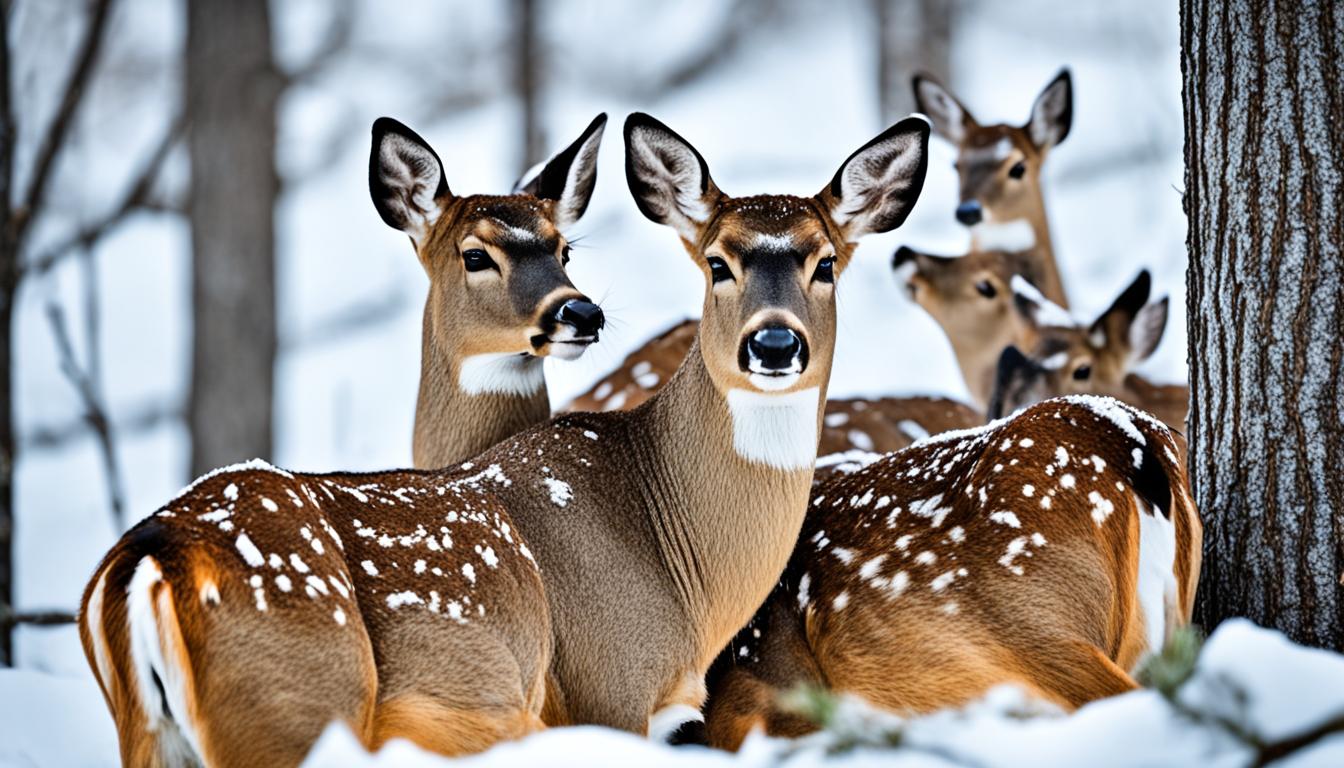Deer, like many other animals, face the challenge of surviving in harsh winter conditions. As temperatures drop and snow blankets the landscape, deer have developed remarkable adaptations and strategies to stay warm and thrive. In this article, we will explore the various techniques and behaviors that help deer withstand the cold and ensure their survival during the winter months.
Content Highlights
ToggleKey Takeaways:
- Deer have thick fur that provides insulation and traps heat.
- They also have a layer of fat under their skin, which acts as an additional insulator.
- Seeking shelter in thickets or under evergreen trees helps deer protect themselves from the wind and snow.
- Deer use their antlers to brush away snow and access food sources.
- In winter, deer adjust their diet to include higher-calorie foods for increased energy.
The Role of Fur and Fat in Winter Survival
In preparation for winter, deer undergo several physiological changes that help them survive the cold weather. One of the key adaptations is the growth of a thicker coat of fur. This fur plays a crucial role in insulating the deer and keeping them warm during the winter months.
The outer layer of the deer’s fur consists of long, hollow hairs that trap air. These hairs act as excellent insulators, creating a barrier against the cold temperatures outside. The undercoat, on the other hand, is denser and provides additional warmth. Together, these layers of fur help the deer retain their body heat and prevent it from escaping into the surrounding environment.
Deer also have a layer of fat under their skin, known as adipose tissue, which acts as insulation. This fat provides an extra layer of protection against the cold and helps regulate the deer’s body temperature. In harsh winter conditions, when food may be scarce, deer can rely on their fat stores for energy. By reducing their activity level and conserving heat, they can conserve energy and stay warm.
Overall, the combination of thick fur and fat enables deer to withstand the cold temperatures and harsh conditions of winter. These physiological adaptations allow them to survive and thrive during the colder months when resources are limited.

Behavioral Adaptations for Winter Survival
During the winter months, deer employ various behavioral adaptations to ensure their survival in harsh conditions. These adaptations include seeking shelter, foraging for food, and adjusting their diet to meet the demands of the season.
Shelter in Winter: In order to protect themselves from the cold, deer seek out areas such as thickets or take refuge under evergreen trees. These areas provide some protection from the wind and snow, allowing the deer to conserve body heat.
Foraging in Winter: When faced with snowy conditions, deer use their antlers to brush away snow from their food sources. This enables them to access the vegetation that lies beneath the snow, ensuring a continued food supply even during the winter months.
Winter Diet: Deer also make significant changes to their diet in winter. They add higher-calorie foods, such as nuts, berries, and mushrooms, to their usual diet of grasses and plant material. These extra calories provide the necessary energy for the deer to maintain their body heat and cope with the demands of the colder season.
Overall, deer’s behavioral adaptations for winter survival allow them to find shelter, obtain nourishment, and conserve energy. These strategies have evolved to help deer thrive in the face of cold temperatures, ensuring their survival until the arrival of spring.

Winter Survival Strategies
| Behavioral Adaptations | Explanation |
|---|---|
| Seeking Shelter | Deer find areas like thickets and evergreen trees that offer protection from the cold. |
| Brushing Away Snow | Using their antlers, deer clear away snow from their food sources to access vegetation. |
| Adjusting Diet | Deer add higher-calorie foods to their diet to provide more energy for body heat maintenance. |
Conclusion
Deer have developed ingenious strategies to keep warm and survive the harsh winter conditions. Their thick fur, layer of fat, and changes in behavior all play crucial roles in their winter survival. The long, hollow hairs of their fur trap heat and provide insulation, while the layer of fat acts as an additional insulating barrier. Seeking shelter in thickets or under evergreen trees helps deer find protection from the cold wind and snow, ensuring they can conserve heat and energy. Adjusting their diet to include higher-calorie foods gives them the necessary energy to cope with the demands of winter. These adaptations and behaviors collectively enable deer to endure the cold temperatures and emerge strong until spring arrives.
By understanding and appreciating the winter survival strategies of deer, we gain a greater respect for their remarkable resilience and adaptability. The ability of deer to withstand extreme conditions is a testament to the wonders of nature and the marvels of animal adaptation. As we observe deer keeping warm in winter, we are reminded of the importance of conserving and protecting their habitats, ensuring their continued survival for generations to come.
In conclusion, the strategies employed by deer to stay warm in winter are a testament to their incredible survival instincts. Through their thick fur, layer of fat, seeking shelter, and adjusting their diet, deer are able to brave the cold temperatures and harsh conditions of winter. It is awe-inspiring to witness these remarkable animals thriving in the face of adversity. Let us continue to admire and respect the winter survival strategies of deer, appreciating the wonders of nature and the incredible adaptations that allow these magnificent creatures to flourish even in the coldest months.
- California Deer Hunting Guide: Seasons, Rules, Permits, and More - 26 June 2024
- Arkansas Deer Season 2024 [Schedules, Licenses, Bag Limits & More!] - 26 June 2024
- 2024 Arizona Deer Season New Dates & Rules! - 25 June 2024




